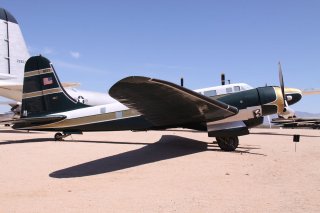Douglas B-23 Bomber: The World War II Bomber That Barely Bombed
After the United States entered World War II in December 1941 the B-23 Dragon was relegated to use as a patrol aircraft on the west coast and later for training duties.
In the late 1930s, the Douglas Aircraft Company developed a new bomber to address and even rectify the shortcomings of the unloved twin-engine B-18 Bolo Bomber. Initially, Douglas had proposed a number of modifications for the B-18, and the United States Army Air Corps saw the potential of an upgrade and this evolved into the Douglas B-23 Dragon.
The refined aircraft featured upgraded engines, a considerably larger wingspan that was similar to that of the DC-3 transport plane, improved fuselage, a fully retractable undercarriage but notably vastly improved defense capabilities. The B-23 was the first operational bomber equipped with a glazed tail gun position, which also included the more powerful M2 .50 caliber machine gun—replacing the .30 caliber used in other bombers. However, the gun was still operated by a gunner who had to lie in a prone position and use a telescopic sight to target the enemy.
The first B-23 (S/N 39-27) was completed in July of 1939 and it completed its first flight from Clover Field to Santa Monica the same month. The aircraft was evaluated by the Material Division at Wright Field in Ohio and deliveries of the bomber began the next year.
A total of 38 B-23s were produced between July 1939 and September 1940—but it was soon apparent that the B-23 just wasn’t the bomber the Air Corps needed. While it was significantly faster and better armed than the B-18 Bolo, it was inferior in terms of speed an armament to the Boeing B-17, North American B-25 Mitchell and Martin B-26 Marauder. As a result, this Dragon was never used in its intended bombardment role and never saw combat overseas.
After the United States entered World War II in December 1941 the B-23 Dragon was relegated to use as a patrol aircraft on the west coast and later for training duties. Some were later converted into transports, where the aircraft were redesignated the UC-67.
The true lasting legacy, however, is that the B-23 was used as a testbed for new engines and systems.
After the end of the war, between fifteen and eighteen of the Dragons were sold as surplus as converted for use as corporate/executive transports, where the aircraft were refitted with a longer metal nose, full washroom facilities. As the UC-67, it could carry twelve passengers in two compartments. General Electric reportedly acquired five while billionaire Howard Hughes used a converted B-23 as his personal aircraft for a short time—but one can only speculate as to whether he “entertained” Jane Russell or other actresses in the plane.
The B-23/UC-67 was powered by two Wright R-2600-3 Radial piston engines with 1,600 horsepower each and had a maximum speed of 282 miles per hour with a range of 1,400 miles and a ceiling of 31,600 feet. In its bomber capacity, it had a crew of five including the pilot, co-pilot, radio operator, bombardier and tail gunner.
Peter Suciu is a Michigan-based writer who has contributed to more than four dozen magazines, newspapers and websites. He is the author of several books on military headgear including A Gallery of Military Headdress, which is available on Amazon.com.

